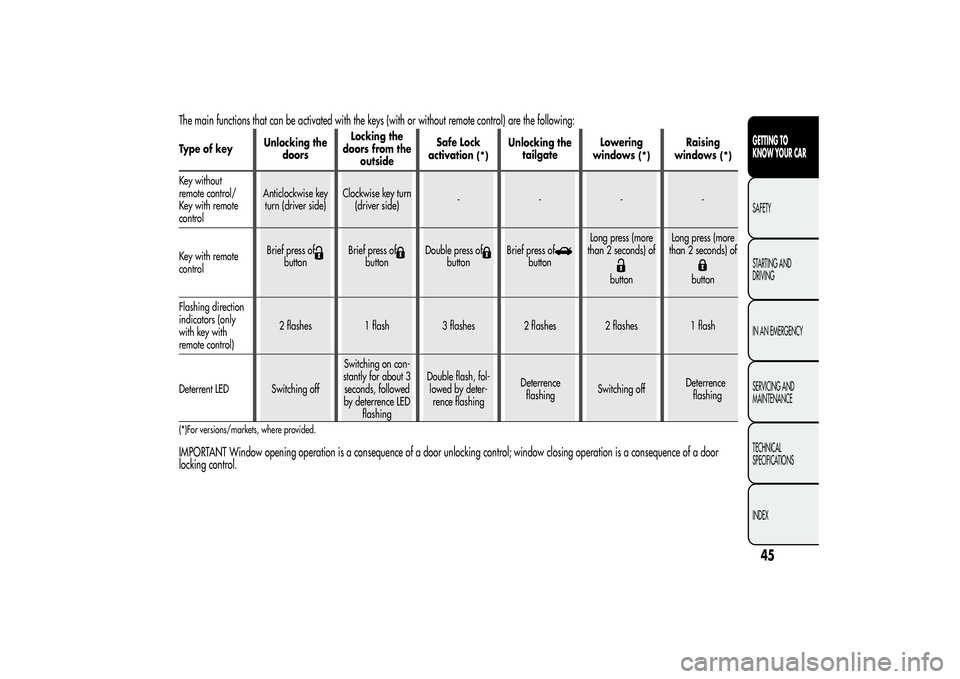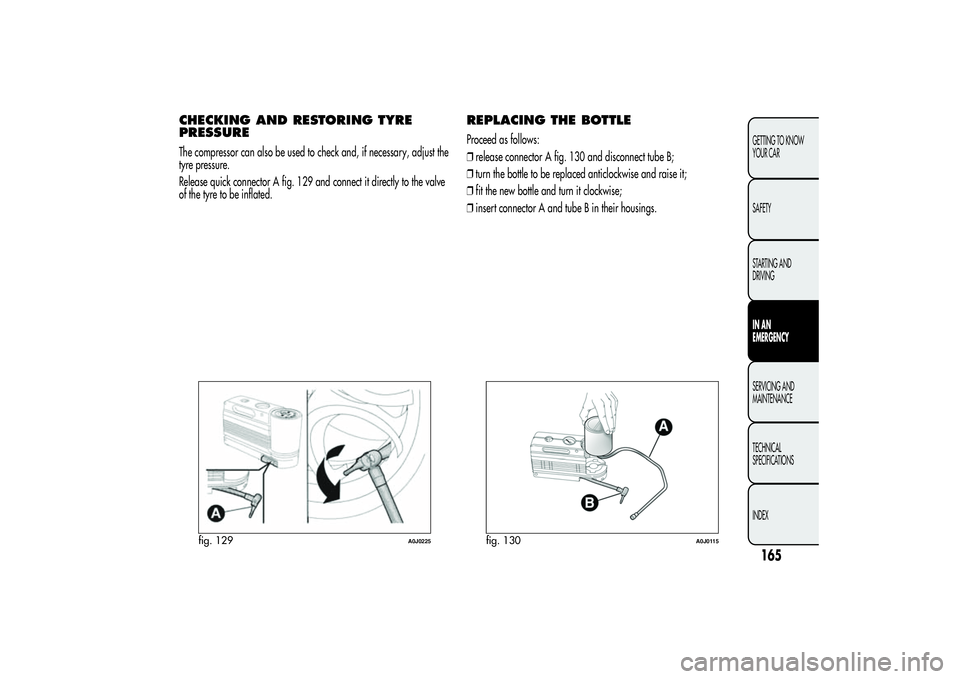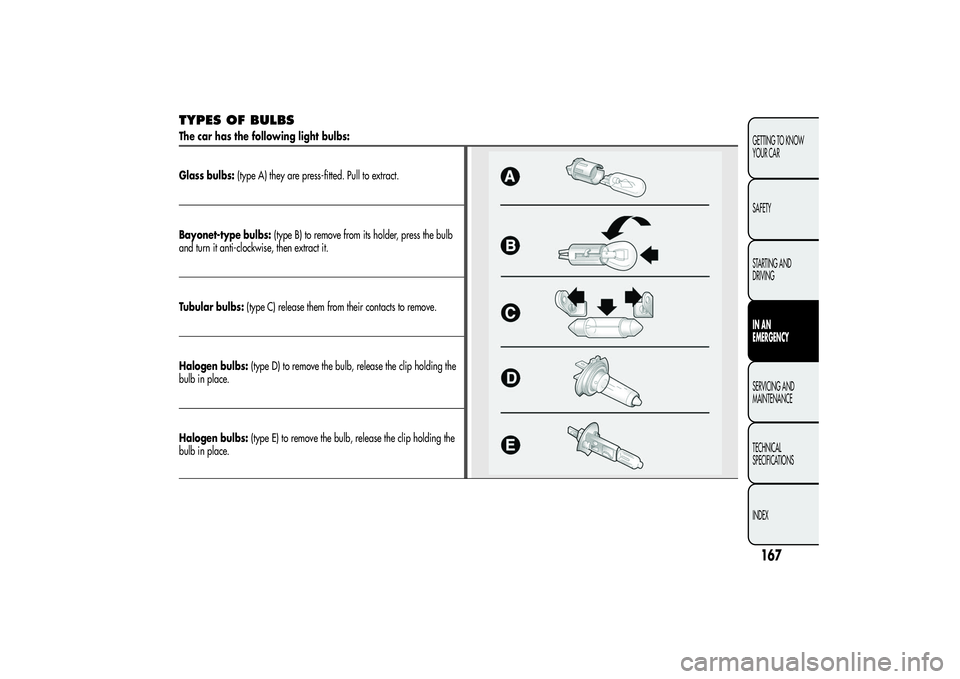clock Alfa Romeo MiTo 2013 Owner handbook (in English)
[x] Cancel search | Manufacturer: ALFA ROMEO, Model Year: 2013, Model line: MiTo, Model: Alfa Romeo MiTo 2013Pages: 312, PDF Size: 11.5 MB
Page 34 of 312

Rain sensor (Rain sensor sensitivity
adjustment)This function allows you to adjust the rain sensor sensitivity to 4 levels.
To set the required sensitivity level proceed as follows:
ŌØÆbriefly press MENU ESC: the previously set sensitivity level will flash
on the display;
ŌØÆpress the + or - button to adjust;
ŌØÆpress the MENU ESC button briefly to return to the menu screen or
hold the button down to return to the standard screen without
storing.Activation/Trip B data (Trip B
enablement)This function may be used to activate (On) or deactivate (Off) the Trip B
(partial trip). For further information see ŌĆ£Trip computerŌĆØ.
Proceed as follows to switch the function on and off:
ŌØÆpress the MENU ESC button briefly to make the display flash On or
Off according to the previous setting;
ŌØÆpress the + or - button to select;
ŌØÆpress the MENU ESC button briefly to return to the menu screen or
hold the button down to return to the standard screen without
storing.
Time adjustment (Clock adjustment)This function enables the clock to be set through two sub-menus:
ŌĆ£TimeŌĆØ and ŌĆ£FormatŌĆØ.
To carry out the adjustment, proceed as follows:
ŌØÆbriefly press MENU ESC: the display will show the two submenus
ŌĆ£TimeŌĆØ and ŌĆ£ModeŌĆØ;
ŌØÆpress the + or - button to move between the two submenus;
ŌØÆonce the submenu to be modified has been selected, briefly press the
MENU ESC button;
ŌØÆwhen you select the ŌĆ£TimeŌĆØ submenu, pressing MENU ESC briefly
makes the "hours" flash on the display;
ŌØÆpress the + or - button to adjust;
ŌØÆbriefly press MENU ESC: the ŌĆ£minutesŌĆØ will flash on the display;
ŌØÆpress the + or - button to adjust.
IMPORTANT Each press on the + or - buttons causes an increase or
decrease of one unit. Hold down the button to increase/decrease the
setting rapidly and automatically. Complete the setting by with single
presses of the button when you approach the required value.
ŌØÆIf you select ŌĆ£FormatŌĆØ submenu, pressing MENU ESC briefly makes
the display mode flash on the display;
ŌØÆpress + or - to select ŌĆ£24hŌĆØ or ŌĆ£12hŌĆØ.
When you have made the required adjustments, briefly press button
MENU ESC to go back to the submenu screen or hold the button down
to go back to the main menu screen without saving.
ŌØÆhold the MENU ESC button down again to go back to the standard
screen or to the main menu according to the position in the menu.
30GETTING TO
KNOW YOUR CAR
SAFETY
STARTING AND
DRIVING
IN AN EMERGENCY
SERVICING AND
MAINTENANCE
TECHNICAL
SPECIFICATIONS
INDEX
Page 49 of 312

The main functions that can be activated with the keys (with or without remote control) are the following:Type of keyUnlocking the
doorsLocking the
doors from the
outsideSafe Lock
activation
(*)
Unlocking the
tailgateLowering
windows
(*)
Raising
windows
(*)
Key without
remote control/
Key with remote
controlAnticlockwise key
turn (driver side)Clockwise key turn
(driver side)----
Key with remote
controlBrief press of
buttonBrief press of
buttonDouble press of
buttonBrief press of
buttonLong press (more
than 2 seconds) of
buttonLong press (more
than 2 seconds) of
button
Flashing direction
indicators (only
with key with
remote control)2 flashes 1 flash 3 flashes 2 flashes 2 flashes 1 flash
Deterrent LED Switching offSwitching on con-
stantly for about 3
seconds, followed
by deterrence LED
flashingDouble flash, fol-
lowed by deter-
rence flashingDeterrence
Switching offDeterrence
(*)For versions/markets, where provided.IMPORTANT Window opening operation is a consequence of a door unlocking control; window closing operation is a consequence of a door
locking control.
45GETTING TO
KNOW YOUR CARSAFETY
STARTING AND
DRIVING
IN AN EMERGENCY
SERVICING AND
MAINTENANCE
TECHNICAL
SPECIFICATIONS
INDEX
flashing flashing
Page 91 of 312

INITIALISATION PROCEDUREAfter the battery has been disconnected or a fuse has blown, the
operation of the sun roof must be initialised again.
Proceed as follows:
ŌØÆpress button B fig. 52 until the roof is completely closed. Release the
button;
ŌØÆpress B button and keep it pressed for at least 10 seconds and/or
until the glass panel clicks forwards. Release the button at this point;
ŌØÆwithin 5 seconds of the previous operation, press button B and hold
it down: the front glass panel will complete a full opening and
closing cycle. Only release the button at the end of this cycle.
MAINTENANCE/EMERGENCYIn the event of emergency or maintenance, the roof can be moved
manually when there is no power supply (opening/closing of the front
glass panel) by carrying out the following operations:
ŌØÆremove the protective cap A fig. 54 located on the internal lining,
between the two sun blinds;
ŌØÆtake the Allen key B supplied, which is located in the on-board
documentation container or in the tool container in the luggage
compartment;
ŌØÆintroduce the key into housing C and turn it clockwise to open the
roof or anticlockwise to close the roof.
fig. 54
A0J0328
87GETTING TO
KNOW YOUR CARSAFETY
STARTING AND
DRIVING
IN AN EMERGENCY
SERVICING AND
MAINTENANCE
TECHNICAL
SPECIFICATIONS
INDEX
Page 126 of 312

REFUELLING THE CARStop the engine before refuelling.PETROL ENGINESOnly use unleaded petrol. The petrol octane rating (RON) must not be
lower than 95. In order to prevent damage to the catalytic converter
never introduce even the smallest amount of leaded petrol, even in the
event of an emergency.DIESEL ENGINESUse only diesel fuel compliant with European specification EN590. The
use of other products or mixtures may damage the engine beyond
repair and consequently invalidate the warranty, due to the damage
caused.
Operation at low temperatures
If the outside temperature is very low, the diesel thickens due to the
formation of paraffin clots with consequent defective operation of the
fuel supply system.
In order to avoid these problems, different types of diesel fuel are
distributed according to the season: summer type, winter type and
arctic type (cold/mountain areas). If refuelling with diesel fuel whose
features are not suitable for the temperature of use, it is advisable
to mix TUTELA DIESEL ART additive with the fuel, in the proportions
shown on the container. Pour the additive into the tank before the fuel.
When using or parking the vehicle for a long time in the mountains
or cold areas, it is advisable to refuel using locally available fuel.
In this case, it is also advisable to keep the tank over 50% full.
FUEL TANK CAPThe fuel flap is unlocked when the central locking system is released
and automatically locked when the central locking system is applied.
Opening
Open flap A fig. 88, pulling it outwards, hold cap B still, insert the
ignition key in the lock and turn it anticlockwise. Then turn the cap
anticlockwise and remove it.
The plug is provided with a loss prevention device C which secures it to
the flap, so it cannot be lost. Attach the cap to device D during
refuelling.
fig. 88
A0J0327
122GETTING TO
KNOW YOUR CAR
SAFETY
STARTING AND
DRIVING
IN AN EMERGENCY
SERVICING AND
MAINTENANCE
TECHNICAL
SPECIFICATIONS
INDEX
Page 127 of 312

Closure
Fit the cap (complete with key) and turn it clockwise until it clicks once
or more. Then turn the key clockwise and extract it, then close the flap.
The sealing may cause a slight pressure increase in the tank. A little
breathing off, while slackening the cap is absolutely normal.
Do not place naked flames or lit cigarettes near to the
fuel filler: fire risk. Also, keep your face away from
this fuel inlet to avoid inhaling harmful fumes.
PROTECTING THE ENVIRONMENTThe following devices are used for reducing petrol fuel engine
emissions: catalytic converter, oxygen sensors and evaporation control
system
The following devices are used for reducing diesel fuel engine
emissions: oxidising catalytic converter, exhaust gas recirculation
system (EGR) and particulate filter (DPF).DIESEL PARTICULATE FILTER (DPF)(for versions/markets, where provided)
This is a mechanical filter, fitted in the exhaust system, which almost
completely eliminates carbon particle emissions.
The catalytic converter and particulate filter (DPF) reach
very high temperatures during operation. Therefore
do not park the car on flammable materials (grass, dry
leaves, pine needles etc.): fire hazard.
123GETTING TO
KNOW YOUR CARSAFETY
STARTING AND
DRIVING
IN AN EMERGENCY
SERVICING AND
MAINTENANCE
TECHNICAL
SPECIFICATIONS
INDEX
Page 145 of 312

IMPORTANT
Do not wash the seats with water or pressurised steam (by hand or at
automatic seat washing stations).
The front airbags and/or side bags may be deployed if the car is
subject to violent impacts involving the underbody area (e.g. violent
impacts against steps or kerbs, big holes or dips in the road etc.).
When the airbag deploys it emits a small amount of dust: the dust is
harmless and does not indicate the beginning of a fire. The dust may
irritate the skin and eyes however: in this case, wash with neutral soap
and water.
All operations on airbags (inspection, repair and replacement) must be
carried out by Alfa Romeo Authorized Services.
If the car is to be scrapped, contact Alfa Romeo Authorized Services to
have the airbag system deactivated.
Pretensioners and airbags are deployed in different ways, according to
the type of impact. Failure to deploy of one of the devices does not
necessarily indicate a system malfunction.
If the
warning light does not switch on when the
key is turned to MAR, or stays on while driving (on
some versions together with a message on the display)
there may be a fault in the restraint systems. In this case, airbags
or pretensioners may not be activated in the case of an accident
or (in a lesser number of cases) they may be activated
incorrectly. Before proceeding, contact Alfa Romeo Authorized
Services to have the system checked immediately.
The expiry dates of the explosive charge and the clock
spring are shown on a specific label contained in the
glove compartment. When these dates approach,
contact Alfa Romeo Authorized Services to have them replaced.Do not travel carrying objects in your lap, in front of
your chest or between your lips (pipe, pencils, etc.):
they could cause severe injury if the airbag is
deployed.If the car has been subject to theft, attempted theft,
vandalism, or flooding, have the airbag system
inspected at Alfa Romeo Authorized Services.
141GETTING TO KNOW
YOUR CARSAFETYSTARTING AND
DRIVING
IN AN EMERGENCY
SERVICING AND
MAINTENANCE
TECHNICAL
SPECIFICATIONS
INDEX
Page 169 of 312

CHECKING AND RESTORING TYRE
PRESSUREThe compressor can also be used to check and, if necessary, adjust the
tyre pressure.
Release quick connector A fig. 129 and connect it directly to the valve
of the tyre to be inflated.
REPLACING THE BOTTLEProceed as follows:
ŌØÆrelease connector A fig. 130 and disconnect tube B;
ŌØÆturn the bottle to be replaced anticlockwise and raise it;
ŌØÆfit the new bottle and turn it clockwise;
ŌØÆinsert connector A and tube B in their housings.
fig. 129
A0J0225
fig. 130
A0J0115
165GETTING TO KNOW
YOUR CAR
SAFETY
STARTING AND
DRIVINGIN AN
EMERGENCYSERVICING AND
MAINTENANCE
TECHNICAL
SPECIFICATIONS
INDEX
Page 171 of 312

TYPES OF BULBSThe car has the following light bulbs:
Glass bulbs:(type A) they are press-fitted. Pull to extract.Bayonet-type bulbs:(type B) to remove from its holder, press the bulb
and turn it anti-clockwise, then extract it.
Tubular bulbs:(type C) release them from their contacts to remove.
Halogen bulbs:(type D) to remove the bulb, release the clip holding the
bulb in place.
Halogen bulbs:(type E) to remove the bulb, release the clip holding the
bulb in place.
167GETTING TO KNOW
YOUR CAR
SAFETY
STARTING AND
DRIVINGIN AN
EMERGENCYSERVICING AND
MAINTENANCE
TECHNICAL
SPECIFICATIONS
INDEX
Page 174 of 312

DIPPED HEADLIGHTSWith incandescent bulbs
To change the bulb, proceed as follows:
ŌØÆremove cover B fig. 131;
ŌØÆremove cover A fig. 133 protecting the bulb;
ŌØÆextract the bulb and replace it;
ŌØÆrefit the bulb holder, making sure it is correctly secured;
ŌØÆrefit cover B fig. 131.
With gas discharge bulbs (Bixenon)
(for versions/markets, where provided)
Contact Alfa Romeo Authorized Services to have these
bulbs replaced.
DIRECTION INDICATORSFront
To replace the bulb, take wrench A fig. 134 (located in the document
holder), insert it in housing B and turn the bulb holder anticlockwise.
Extract the bulb and replace it.
fig. 133
A0J0040
fig. 134
A0J0018
170GETTING TO KNOW
YOUR CAR
SAFETY
STARTING AND
DRIVING
IN AN
EMERGENCY
SERVICING AND
MAINTENANCE
TECHNICAL
SPECIFICATIONS
INDEX
Page 175 of 312

Side
To change the bulb, proceed as follows:
ŌØÆoperate lens A fig. 135 in order to compress clip B, then pull the unit
outwards;
ŌØÆturn bulb holder C anticlockwise, remove the bulb and replace it;
ŌØÆrefit bulb holder C in the lens, turning it clockwise;
ŌØÆrefit the unit, making sure that internal clip B clicks into place.FOG LIGHTS(for versions/markets, where provided)
For the replacement of these bulbs, contact Alfa Romeo Authorized
Services.
REAR LIGHT CLUSTERSTo access the light cluster, move the luggage compartment side trim
(see fig. 136). These contain the bulbs for the side lights, direction
indicators and brake lights.SIDE LIGHTS/BRAKE LIGHTSThese are LED lights. Contact Alfa Romeo Authorized Services to
replace these lights.
fig. 135
A0J0042
fig. 136
A0J0043
171GETTING TO KNOW
YOUR CAR
SAFETY
STARTING AND
DRIVINGIN AN
EMERGENCYSERVICING AND
MAINTENANCE
TECHNICAL
SPECIFICATIONS
INDEX